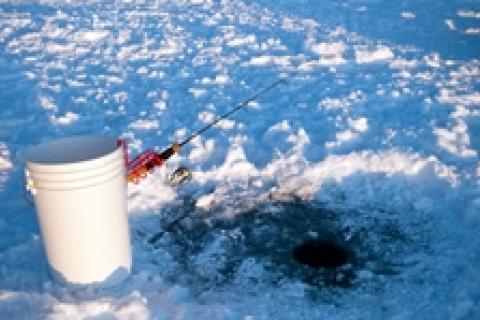
Recently I was ice fishing for walleye on a lake and experienced rather slow action. It was a classic mid-winter doldrums scenario. Fish were inactive most of the day and when dusk arrived the feeding was brief. While finesse jigging produced a few walleye, soaking a 3.5-inch minnow on a set-line put the bulk of the fish on the ice.
 |
| A dead-stick rod helps cover more water and catch more fish. |
When it comes to ice fishing, set-lines are stellar. I see them as a silent partner to boost the day's catch stats. Whether a tip-up or a dead-stick rod, using an extra line allows you to cover more water, while simultaneously giving fish more than one snack to choose from.
When jigging for walleye, yellow perch, or crappie I use a dead-stick rod to soak a minnow. The soft-tipped pole is secured in a rod holder; the reel's drag set loose. This stick is kept close so I can quickly grab it and set the hook when a fish takes the bait and loads the rod. Positioning a set-line near the jigging hole is also advantageous because the commotion of the lure will attract fish to the area. Some will eat the bait you're working. Others will refuse but end up taking the minnow dangling from the nearby set-line.
Generally, I prefer using a vertical ice jig to hook a minnow behind, and to the side, of the dorsal fin. Other options include tail-hooking a baitfish on a treble dangling below a split shot or hooking a minnow through the nose with a ball jig head. Some days fish prefer the action of one approach over the other, so be sure to experiment and let the biting fish tell you what they want. The same also goes for where in the water column to position the set-line bait. Reference fish signals on electronics and vary depth until you hone-in on the sweet spot.
I'm also a fan of using set-lines when targeting northern pike but with slightly varied tactics. I increase the distance between my jigging hole and the set-line. This is done mainly to prevent a hooked pike from tangling the two lines during the fight. Spreading things out also helps cover more area. Pike may find the set-line on their own, spot it en route to investigating the commotion of a jigging lure, or discover the minnow while snooping around the area after declining the bait you're working. Whether using a beefy ice rod or a tip-up for pike, a quick-strike rig is best for presenting a live or a dead baitfish as the dual hooks allow for immediate hook-sets.
Be sure to read the fishing regulations on set-line limits, live bait rules, and hook rigging allowances as these can be different from one zone to another and, at times, will change from one year to the next.
- 4527 views

